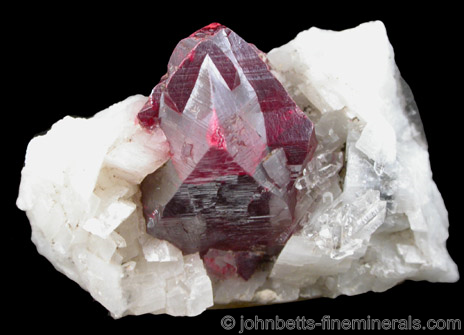The Mineral cinnabar

Cinnabar is the chief mineral composed of the element mercury, and is a very important ore mineral. Though most Cinnabar is massive and uninteresting in habit, several localities produce phenomenal and strikingly colored red crystals that stand out with beautiful contrast on top of a white matrix.
Cinnabar is occasionally associated with Native Mercury, in the form of small metallic blobs perched on top or within cavities of the Cinnabar. Since Cinnabar is composed from mercury which has various health hazards, it is recommended to wash hands after handling Cinnabar specimens.
Color
Bright red, violet-red, scarlet-red, brownish-red, and dark metallic-red.
Properties
Streak
Red |
Hardness
2 - 2.5 |
Transparency
Transparent to opaque |
Specific Gravity
8.0 - 8.1 |
Luster
Adamantine, submetallic, dull |
Cleavage
1,3 |
Fracture
Uneven |
Tenacity
Brittle to slightly sectile |
Other ID Marks
Cinnabar crystals are birefringent, though transparent crystals are often too small or embedded in a matrix for this property to be properly observed.
|
Varieties
-
Agate/Chalcedony or Opal with red bands or red spots of the mineral Cinnabar. It is named after Myrick Spring, San Bernardino Co., California.
Uses
Cinnabar is the most common mercury mineral and is the chief ore of that metal. It is mined extensively for the production of mercury. Aesthetic crystals of Cinnabar, especially those from China, are very popular among mineral collectors. Cinnabar has been historically used as a vermilion pigment.
Noteworthy Localities
The finest Cinnabar crystals in the form of intensely-red bright transparent crystals come from China at Tongren, Guizhou Province, at the specific deposits of Wanshan, Yanwuping, and Yunchangping. Similar crystals occur nearby at the Chatian mine near Fenghuang, Xiangxi, Hunan Province.
Almaden, Ciudad Real, Spain, is probably the most historic (as well as one of the most important) localities for Cinnabar. Specimens from that locality usually massive, but crystals have also been found, and it has also produced specimens in association with small Native Mercury blobs. Other important deposits include Idria, Slovenia; Rudňany, Slovakia; Nikitovka (Horlivka), Donets'ka Oblast, Ukraine; and Chauvai, Alai Range, Kyrgyzstan. In Mexico, a classic locality is Charcas, San Luis Potosí.
The U.S. also contains several important deposits, most notably in the mercury-producing districts of California and Nevada. California deposits include the New Almaden District, Santa Clara Co.; and New Idria and Mount Diablo, Diablo Range, San Benito / Contra Costa Counties. Nevada deposits include the Cahill Mine, Poverty Peak, Humboldt Co.; and Antelope Springs, Pershing Co. Other occurences include Terlingua, Brewster Co., Texas; and Kirby, Pike Co., Arkansas.
Distingushing Similar Minerals
Realgar - Lower in hardness and specific gravity.
Cuprite - Higher in hardness, forms in different crystal habits.
Sphalerite - Higher in hardness, lower specific gravity.